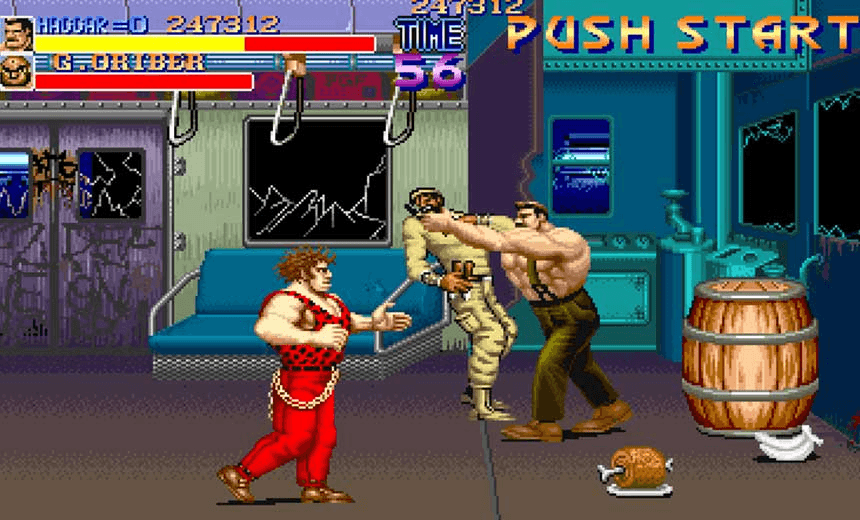Has there ever been a more video gamey genre than the beat ’em up? Liam Maguren doesn’t think so, and here he explains why he loves them so.
Bare-knuckled violence seemed a lot more innocent when I was a child.
I remember having to wedge myself in a corner and stand on my toes just to catch a peek at the Street Fighter 2 arcade screen stationed next to every fish n’ chip shop. I longed to be the 16-bit badass that my brother was, but I didn’t have the dexterity to pull off that back back quarter-circle bullshit those games demanded. So the moment my tiny hands got ahold of Streets of Rage 2, I couldn’t put it down. That was the beauty of beat ‘em ups – they were fighting games for people who sucked at fighting games.
The beat ‘em up subgenre had its golden age around the late ’80s and early ’90s. Most of them had co-operative play, which was a MASSIVE deal back then. The template hardly ever changed: players enter an area and hit the punch button near bad dudes until a giant flashing “GO” sign prompts them to move a little bit so they can keep punching bad dudes. It sounds repetitive as hell, and it was, but so is Pong, Super Mario Bros. and Destiny (don’t @ me).
The bad beat ‘em ups were nothing more than button mashers. The quality ones were also button mashers, but played more like a horizontal version of PUNCH OUT!! where you needed to time your jabs and predict enemy movement patterns.
I couldn’t confidently tell you what game started the beat ‘em up movement (you can argue with videogame historians about that). It certainly gained momentum in 8-bit form with the likes of River City Rampage and Double Dragon. Perhaps the best and worst of that generation was Battletoads, a game with great animation that let you punt enemies into oblivion. You would eventually do this to the game’s cartridge given how brutally difficult it was.
With the introduction of the 16-bit machines, the number of beat ‘em ups produced exploded. While virtually nothing innovative happened on the gameplay front, the sprites and the sound were given major uplifts. The fight for the beat ‘em up throne was not a test of substance; it was a test of style.
Gamemakers weren’t doing much with the subgenre’s formula, especially Capcom and Konami. They were notorious for copy-pasting their mechanics over to heaps of licensed properties like Teenage Mutant Ninja Turtles, Alien vs Predator, X-Men, and The Punisher. Even franchises that didn’t make sense, like The Simpsons and Cadillacs and Dinosaurs, got beat ‘em ups.
I’m not poo-pooing those games for lacking innovation (it’s actually quite unique how the beat ‘em up formula was shoehorned into other properties). One of my all-time favorite games is Streets of Rage II, which blatantly stole from Capcom’s Final Fight. This was a battle for style over substance after all, and SEGA’s sequel had more of it than Channing Tatum recreating the ‘Smooth Criminal’ music video.
[This space will contain the YouTube embed of said music video when ChanTats inevitably does it.]
In the Streets of Rage universe, law enforcement was carried out by a boxer named Axel, a dancer named Blaze, an underage child on skates (his name is Skate), and professional wrestler MAX THUNDER who has no back story. Skate was my favourite since he was the only kid in the group. He made me feel like I could beat up adults in the streets too, which probably wasn’t a healthy thing to encourage in hindsight.
The background art captured a moody urban nightlife incredibly well and the criminals looked like they came out of a Mad Max film directed by Joel Schumacher, just to give you even more motivation to punch them in the face.
There’s more that could be said about the game’s look, lore and feel. But what really gave SoR2 its verve was Yuzo Koshiro’s synth soundtrack. Having warmed his musical fingers with the first Streets of Rage, Koshiro pushed the SEGA Mega Drive’s sound chips to their limits, creating some incredible ahead-of-their-time techno smackers that are nightclub-ready to this day.
I’m lamenting a bygone era even though beat ‘em ups have never really gone away – they just evolved into different forms. Their DNA is visible in many modern action adventure franchises like God of War, Devil May Cry and Bayonetta. The hack-n-slash is essentially the same thing but with swords, spanning its own heritage from Golden Axe to The Lord of the Rings: The Two Towers game and the recent For Honor. Hell, you’ve even got Castle Crashers and the Scott Pilgrim videogame keeping the traditional beat ‘em up taste kicking like an old flavour sachet from a pack of Mygong noodle.
As long as there are players who still like punching faces and still suck at real fighting game, the beat ‘em up will never get KO’ed.
This post has been made with the help and support of Bigpipe Broadband, they is good, real good.

